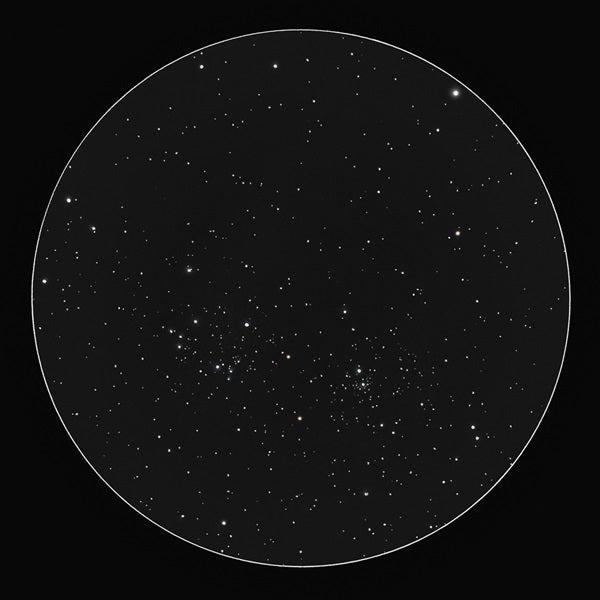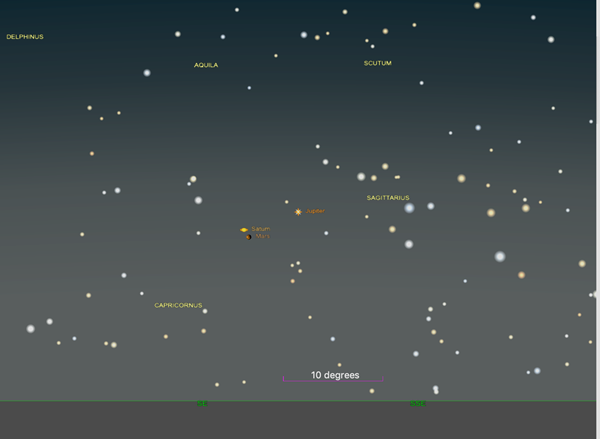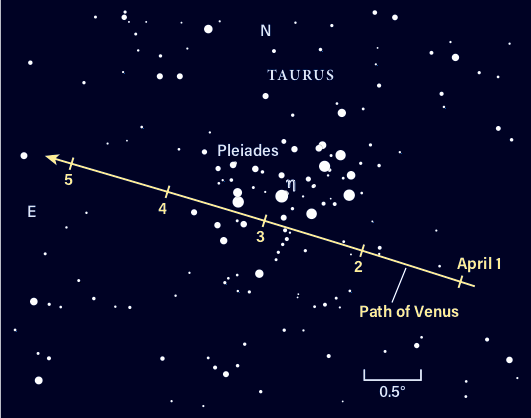The waxing Moon is still less than 12 percent lit and sets shortly after 10 P.M. local time, freeing the deep sky for observers who would rather stay up late than wake up early. After darkness falls, search out the Perseus Double Cluster, also known as NGC 869 and NGC 884 or h and Chi (χ) Persei. This sparkling pair of open clusters is sometimes visible to the naked eye from a dark site, but is also easy to find with binoculars or a small scope.
Many objects appear close to each other in the sky only because of projection effects, but these two young groups of stars are physically close in space as well, only a few hundred light-years apart. Astronomers believe both may have formed from the same massive star-forming cloud of gas and dust, although h (which lies west of Chi) is about 2 million years older than its sibling.
Saturday, March 28
The Moon passes 7° south of the planet Venus at 7 A.M. EDT this morning. Tonight, you can catch the pair — still just 8° apart — more than 40° above the western horizon at sunset and sinking slowly as the night progresses. The Moon is now 18 percent lit, while Venus is almost 50 percent illuminated.
Curious comet hunters may want to try finding C/2019 Y4 (ATLAS), which is brightening dramatically as it speeds closer to the Sun. Still months from rounding our star at perihelion, the comet is currently at magnitude 8 and located in Ursa Major, about 63° north of Venus. The bright star Capella lies roughly halfway between the two, forming the point of a long, low triangle connecting the three.
Sunday, March 29
Eighth-magnitude Vesta slips past the crescent Moon this morning in Taurus the Bull. At 3 A.M., the two are separated by just 0.2°, but below the horizon. By sunset, the two are much farther apart — 8° — and Vesta now hangs about halfway between the Moon and Venus in the west, just 7° southeast of the Pleiades (M45). East of the asteroid is the familiar v shape of the Hyades Cluster as well as ruddy, bright Aldebaran, the eye of Taurus.
Monday, March 30
Rise early this morning to find Scorpius the Scorpion and his famous red-hued heart, Antares, skimming near the southern horizon in the hours before sunrise. Magnitude 1 Antares’ name means “rival of Mars,” indicating just how easily the bright star can be mistaken for the Red Planet. In fact, turn to the southeast and you’ll see the real deal: Mars shines just a bit brighter — magnitude 0.8 — and lies clustered with Saturn less than 2° to its north and Jupiter about 5.5° to the west. The Red and Ringed Planets are inching ever closer, and their big meeting is just a day away.
This morning brings us the second of March’s two planetary conjunctions. Having left Jupiter behind, Mars closes in on Saturn in the southeastern sky against the glittering stars of Capricornus. By 7 A.M., the two worlds stand just 0.9° apart.
Early risers can catch the conjunction, which is best seen in the hour or so before sunrise. As a bonus, brilliant Jupiter sits just 6° west of Mars and Saturn, which glow at roughly the same magnitude: 0.8 and 0.7, respectively.
Wednesday, April 1
First Quarter Moon occurs at 6:21 A.M. EDT. This evening, look for our waxing satellite just 6° below Pollux, the bright, gold-colored star in Gemini the Twins. Castor, which sports roughly the same magnitude but a whiter hue, sits just to the north of Pollux. Look below the pair, toward the horizon, and you’ll find Orion the Hunter standing upright as he aims his bow at Taurus the Bull, to the west. Orion’s bright shoulder, Betelgeuse, has been undergoing strange changes in brightness over the past several months. Note how bright it appears today, then compare it to your observations days or weeks from now.
Thursday, April 2
Today marks the 175th anniversary of the first surviving photograph of the Sun. The roughly 5-inch daguerreotype was made by Louis Fizeau and Leon Foucault, and captured details including several sunspots visible on our star’s disk.
As spring begins to bring warmer temperatures and clearer days to the Northern Hemisphere, consider doubling your observing time by looking at our closest star.
Solar observing is dangerous without the right equipment. Unless you have an approved solar filter, never use your telescope, viewfinder, or binoculars to look at the Sun. Instead, you may be able to view the Sun safely by turning your small telescope into a solar projector, rather than looking through the scope directly. Alternatively, you can easily build a pinhole projector box to examine the Sun’s disk and look for any sunspots that may darken its face.
Asteroid Juno reaches opposition at 4 P.M. EDT. After dark, try to spot the 145-mile-wide (234 kilometers) world, which shines at magnitude 9.5, rising in the east about 2° south of magnitude 3.4 Delta (δ) Virginis.
Mercury passes just 1.4° south of Neptune at 11 A.M. EDT. The pair rises shortly before the Sun, but early-morning observers may be able to spot the solar system’s speediest planet, shining at magnitude 0.0, a scant 3° above the eastern horizon about 30 minutes before sunrise. The ice giant, far in the distance, is too faint to see in the creeping twilight.
Evening observers will find brilliant Venus among the familiar “little dipper” of the Pleiades (M45) this evening in the western sky. The planet is likely the first thing you’ll see as twilight descends, standing nearly 45° above the horizon. Venus currently dazzles at magnitude –4.6 and will reach greatest brilliancy later this month on the 27th. By 8 P.M. local time, the cluster’s stars will begin to emerge, particularly for observers with binoculars.

Our exclusive Sky Guide 2020 is now available! This free downloadable pamphlet contains a month-by-month rundown of 2020’s biggest celestial events, from Mars’ best opposition in years to the return of totality in South America this December. Check out Astronomy’s Sky Guide 2020 now!












